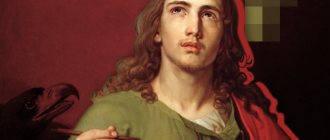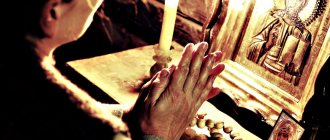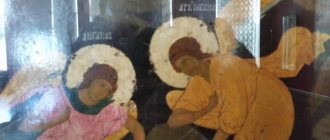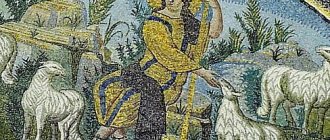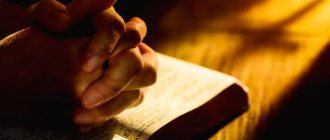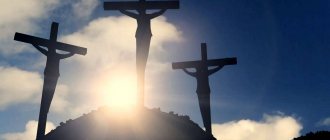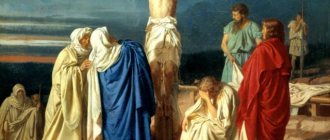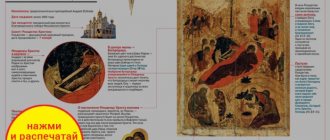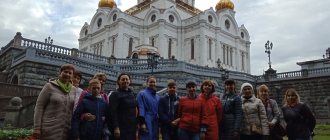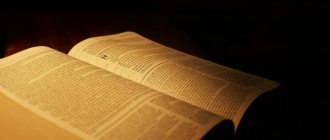Most of all in the modern world, people lack love, mercy, understanding, because in order to give love, you must have it. The human world with its cruel laws cannot fill the soul with tenderness, since only God can do this.
Christians who dream of serving other people in this life must ask the Creator to fill them with the holy anointing to love other people in order to bring God’s grace to the world with an unselfish heart.
The icon of the Apostle John the Theologian is a holy image of the messenger of Love; prayer to him fills the heart with patience, forgiveness and love.
Meaning of the icon
The Apostle John was the youngest disciple of the Savior; time has shown that it was he who turned out to be the most faithful, not being afraid of punishment, he remained with Christ during the crucifixion of Jesus on the cross of Calvary. Of all the disciples, who were older and more experienced in life, the Lord chose the youngest and entrusted him with the most precious thing, His Mother, after His crucifixion. The Most Holy Mary lived in the house of John’s parents until her death and rested there.
Apostle John the Theologian
The Apostle of Love carried his teaching about God’s mercy and grace through all trials; the message that God is Love runs through all his messages as a red thread. The epistles of John constantly emphasize that God loves this world through the love of people for each other. Serving people with love lies the meaning of the whole life of the younger disciple of Jesus.
The most important thing for a person living on earth is in the future, in eternal life, and it depends only on the Christian where he will spend eternity, in heaven or hell.
In the theology of the holy apostle, the border separating the present and the future is destroyed. For him, everything that happens here and now is temporary.
Important! The evangelist throughout his life called people to a life of holiness, filled with God; without knowing the will of the Creator it is impossible to live a sinless life.
Evangelist John the Theologian was the only one of all the apostles who lived to a ripe old age and died a natural death, having survived persecution of Christians, being put to death and many years of hard labor.
Read about the apostles:
- Apostle Thomas
- Holy Chief Apostle Peter
- Icon of the 12 Apostles
The significance of the icon “John the Theologian” is difficult to overestimate; in the appearance of the saint we find unshakable faith and devotion, unfeigned love for humanity.
On a note! The Orthodox world celebrates May 8 as the day of veneration of St. John the Theologian, as a remembrance of the miraculous appearance of pink ashes over his burial place.
Childhood and youth
Church literature claims that the family of the Apostle John traces its origin back to King David. The betrothed husband of the Blessed Virgin Mary, Joseph the Carpenter, had a daughter, Salome, who married Zebedee. Salome and Zebedee had two sons: James and John.
Young Apostle John
Evangelist Mark mentions in the writings that John, his older brother James and his father were fishing from a boat when the call of Christ sounded. The brothers left their catch and their father and followed the Lord. Luke in the writings adds that the newly minted apostles were present at the miraculous fishing and, impressed, turned to the Savior. The young men did not doubt their choice for a moment: they left everything they had and followed the Teacher.
For his impulsive character, keen sense of justice and masterful use of words, Christ nicknamed John the Theologian “Son of Thunder.” These features clearly manifested themselves during the ninth and last walk of the Lord through Galilee: Jesus wanted to go to Jerusalem, but before that he sent messengers to the Samaritan village.
Apostle brothers James and John
However, the residents of the settlement did not accept the Savior. Then John and his brother Jacob asked Christ if they could call fire from heaven to punish the inhabitants of the Samaritan village, but the Lord stopped the excited apostles, because Jesus brings salvation to people, not punishment.
The Apostle John, together with his brother James, were especially close to Peter and were considered closest to the Lord.
Description of the holy image
The first icons depicting the Apostle of Love were painted in the 3rd-4th century, they are found in catacombs and on sarcophagi, where the saint or the beloved disciple of Christ is painted among the twelve or 4 disciples standing near Jesus.
John the Theologian and Prokhor
There is no single image of the holy Theologian in iconography. On the icons he is depicted as a meek, majestic old man, whose features are filled with virginal tenderness. The mark of calm peace is on the forehead, ineffable revelations are read in the eyes. Often near the evangelist you can see the faithful disciple Prokhor, who went through hard labor with his teacher on Patmos.
There are many images of the Apostle of Love, in which he is an old man who has already lived his life, in others - a young man.
Icon painters depict the holy Theologian with a book in his hands and an eagle sitting next to him, symbolizing deep evangelical faith.
The holy image of “John the Theologian in Silence” is especially impressive. A distinctive feature of this image is the hand of the apostle, raised to his lips in thought, and an angel sitting on his shoulder. On the evangelist’s lap lies an open book, most likely the Gospel or the book of Revelation.
Icon painters in the image of an eagle, which can be seen on almost all icons, also meant a symbol of the strength granted to the beloved disciple by Jesus to endure all the suffering, freedom and heights of his thoughts.
Icon of St. John the Evangelist
In his book “Revelation,” the evangelist, who is in hard labor, describes the animals that meet him at the entrance to paradise, among them there is an eagle.
The Apostle of Love turned his gaze to Heaven, the abode of the Most High God. As a rule, the apostles are depicted writing, and Saint John, in silence and meditation, listens to the words of the Creator, which the Angel conveys to him. In this icon, the Theologian is already a very old man, because he wrote his gospel at the end of hard labor on Patmos, where he ended up at the age of 80.
Particular attention of Christians is drawn to the icons of John the Theologian with stamps, which depict almost the entire life of the Apostle of Love.
Important! At all times, believers were interested in the personality of Christ’s beloved disciple, drawing strength for personal faith from his exploits.
Apostle and Evangelist John the Theologian
The holy apostle and evangelist John the Theologian, whom According to Orthodox tradition, Salome was the daughter from the first marriage of St. Joseph the Betrothed.
Saint John, the youngest of the apostles, was a young man with a pure, simple heart. He was called the “beloved disciple” of the Lord. He was one of the three closest disciples of Christ and witnessed the manifestation of the Divine Power of the Lord, which He revealed only to a select few. Thus, together with Peter and James, he was present at the resurrection of Jairus’ daughter, the transfiguration of Christ on Mount Tabor, and the Lord’s prayer for the cup in the Garden of Gethsemane.
When the Lord at the Last Supper told the disciples about imminent betrayal, it was the holy Apostle John, who “reclined at the breast of Jesus,” who dared to ask which of them would betray Him. When the Lord was crucified, of all the disciples, only John did not hide, but stood with the Mother of God at the Cross. Jesus, seeing how he grieved, said: “Woman, behold your son!”, and to John: “Behold your mother!” After the death, resurrection and ascension of Christ, John took the Mother of God into his home and did not leave Jerusalem to preach until Her Dormition.
When the disciples cast lots to determine who should go to which lands to preach the Gospel, John got Asia Minor. According to the life of the holy Apostle John, accepted in Greece, he accepted his lot with a heavy heart, because he was afraid of the mortal dangers of the sea voyage, which, as he foresaw, awaited him. Falling to his knees before the apostles, he confessed his cowardice. The apostles asked James, the first bishop of Jerusalem, to offer a prayer to the Lord for the forgiveness of St. John. Jacob did so, after which everyone parted in peace.
When the time came for the apostles to go preaching, John remained in Jerusalem with the Mother of God and lived there until Her Dormition, that is, until approximately the year 50. Then he sailed to Ephesus with Prochorus, one of the first seven deacons, who also became his first hagiographer. As John had foreseen many years before, they were almost immediately shipwrecked. A few hours after departure, a terrible storm arose and the ship sank. All forty-three people on board reached the shore, holding on to the wreckage of the ship. And only Saint John went missing. Prochorus, grieving, went to Ephesus on foot. Forty days later, standing by the sea not far from Mariotis, Prochorus, to his great amazement, saw a huge wave break on the shore and carry out the Apostle John, after which they continued their journey to Ephesus.
According to the traditional version of the life of St. John, their first test in Ephesus was an encounter with a malevolent woman named Romana. She was overweight and had greater physical strength than all the men around her. Romana managed public baths, owned by a local chief named Dioscorides. Having met John and Prokhor, she offered them a job - stoking the fire in the bathhouse and carrying water for food, shelter and a small fee. They agreed, and she put them to work, but soon began to oppress and even beat Saint John. This went on for many days, and in the end Romana came up with the idea of laying claim to John and Prokhor, declaring them his fugitive slaves. She managed to convince the local judge of the validity of her claims, and he gave her papers to own the two people.
The foundation of the bathhouse was laid at the site of the sacrifices, and therefore the demons made their home in them. Young men and girls were dying there, and one day, when Dioscorides’s only son, Domnus, went there, demons strangled him. Dioscorides, having learned about this, died from this unexpected sad news. Romana grieved very much. She came to the apostle and began to beg him for help, Saint John prayed to the Lord, and Domnus was resurrected. Then they went to his father's house, Saint John prayed over him, and he too rose from the dead. Romana deeply repented of her cruel treatment of the Apostle John, and he baptized her along with Dioscorides and Domnus. They became the first Christians of Ephesus.
After their conversion, the pagan holiday of the goddess Artemis was celebrated in Ephesus. The Apostle John joined the crowd of feasters and, standing on the pedestal of the statue of the goddess, addressed the people with a sermon about Christ. An angry crowd of pagans began to throw stones at him, but the grace of God covered him, and not a single stone touched him, but the statue suffered. The attackers became furious and refused to listen to the admonitions of the apostle, who called on them to behave as befits reasonable people, and not wild animals. The crowd went wild and John eventually raised his hands to the sky, asking God to send a sign to bring the people to repentance. And then a strong earthquake broke out, the earth opened up, and a huge powerful jet of steam burst out of the crevice. Of those present, two hundred people fell dead from fear. After the earthquake stopped, St. John prayed for their return to life. They rose from the dead, after which hundreds of Ephesians were baptized.
After some time, Saint John himself went up to the temple and, by the power of prayer, overthrew the main statue of the goddess of this city, and then the entire temple. Seeing all these signs and wonders, thousands of people turned to Christ. Meanwhile, news of the destruction of the temple reached Emperor Domitian (81–96). The emperor was informed that a certain sorcerer had destroyed the main temple of Ephesus. He ordered the Apostle John to be seized and, chained, brought to him. Domitian had persecuted Christians before, and when the Apostle John was brought to him, the emperor ordered to first beat him and then execute him. The Lord protected His chosen one, and the poison that he was forced to drink did not work. Then they threw him into a cauldron of boiling oil, but even here the apostle remained unharmed. The emperor decided that the Apostle John was immortal and exiled him to the island of Patmos.
The Apostle was chained and put on a ship along with his disciple Prokhor. The frightened guards whispered to each other: “We need to keep an eye on him - he is a sorcerer and does terrible things.” On the way to Patmos, one of them fell overboard. The guard's father was on the ship. He grieved very much, and the whole team grieved with him. Considering John a sorcerer, they turned to him for help. He asked them what gods they worshiped. They began to name the names of their many gods, and he asked them how in this host of gods there was not a single one who could save their comrade.
John was taken to the side of the ship from which the guard had fallen, and the apostle, raising his hands to heaven, began to ask the Lord to save the drowned man. Suddenly, waves of hot water began to erupt from the depths of the sea, and one of the waves, hitting the deck, carried a young guard washed overboard to the feet of the apostle. He was alive. Later, through the prayers of the Apostle John, the strong storm subsided, the team, languishing with thirst, received fresh water, and a man suffering from dysentery was healed. The guards and team wanted to free the Apostle John, but he said: “No, my children, this is wrong, you must take me to where you were ordered so that the emperor does not punish you.”
When they sailed to Patmos, to a city called Flora, the guards handed over the Apostle John and Prochorus to the ruler of the city, but at the same time asked John to allow them to stay with him on Patmos. For ten days the apostle instructed them in the faith, then blessed, baptized and sent them away in peace.
In Flora, the Apostle John and Prokhor were settled in the house of a rich man named Myron, the father-in-law of the ruler of the island of Lawrence. Myron's son Apollonides was possessed by the demonic spirit of divination, and when John and Prokhor entered the house, he fled into the desert. The alarmed parents decided that the apostle had cast a spell on him, and then the young man himself, at the suggestion of the devil, sent them a letter in which he claimed that this was so. They brought the Apostle John to the governor, and he put him in prison. The Apostle John asked to be given the opportunity to send a letter to Apollonides, and the ruler agreed, hoping that the “sorcerer’s” letter would remove the spell from the young man.
John wrote: “I command you in the name of Jesus Christ to leave this image of God and from now on never enter into any person. Leave this island and stay in the desert forever.” As soon as the letter was given to the young man, the demon left him, and the young man returned home. Apollonides told his family the long story of his obsession. The whole family was baptized, as well as Myron’s daughter and grandson (that is, the ruler’s wife and son). The ruler himself became a Christian after leaving office.
Through the prayers of the Apostle John, people were healed of physical and mental illnesses, barren women gained the ability to bear children, and unbelievers gained faith. The temples of Apollo and Dionysus on Patmos crumbled to dust as soon as the apostle began to pray. He spent most of his time in exile convincing people to abandon the futility of paganism and turn their eyes to Christ.
At that time, on Patmos there lived a sorcerer named Kinops (translated from Greek this means “dog face”), who wandered through deserted places for years, prophesied, communicating with demons. Many inhabitants of the island considered him a superior being, and after John destroyed the temple of Apollo, the priest of this temple went to Kinops to persuade him to come to the city and take revenge on the Apostle. The sorcerer did not want to leave his desert, but promised to send a demon, instructing him to grab the soul of John and bring it to him. John, seeing the demon approaching from afar, bound him with his word and cast him out into outer darkness. Kinops sent another demon, but he did not return. Finally, the sorcerer sent two demons to John, so that one would attack the saint, and the second would inform the owner about the fate of the first.
John cast out the demon again, and when Kinops learned from the second one what had happened, he himself went to the city to show people his power and destroy John. The enraged sorcerer made the residents believe that he had managed to resurrect three dead townspeople: ghosts in the form of those deceased appeared before the eyes of the crowd, after which everyone praised Kinops. The sorcerer began to boast of his power to the Apostle John, but the apostle calmly replied: “All your signs will soon turn into nothing,” and the ghosts disappeared. The relatives and friends of the deceased thought that the resurrected had again gone to the land of death, and they attacked John in rage. He was beaten and abandoned, thinking he was dead. That night, Prokhor and Myron, having come for his body, saw that he was not only alive, but standing, kneeling, in prayer in the very place where he was beaten.
Soon after this, Kinops again approached him on the seashore and, indignant that he continued to preach, shouted that he would put him to shame. The Magus ordered the people: “Take him and do not let him or the others go until I return in glory.” Then he jumped into the sea and disappeared from sight. When he disappeared into the waves, John stretched out his hands in a cross shape and prayed that Kinops, this great deceiver, would remain forever in the abyss of the sea and that no one would see him again among the living. John finished praying, and at the same moment a terrible clap of thunder was heard, the sea became agitated, but Kinops did not appear. Then the relatives of those three deceased again tried to kill John, shouting that he had used witchcraft to make Kinops and their relatives disappear. However, everyone else in the crowd insisted that they must wait for the sorcerer's return.
The people waited on the shore for three days and three nights, not daring to disperse, since the sorcerer ordered them to remain in that place. The people suffered greatly from the scorching sun, hunger and thirst, and in the end their three small children died. Saddened by the ease with which they succumbed to deception, and grieving over the hardness of their hearts, John prayed to the Lord for their salvation, asking them to go home and eat. By the power of Christ, he resurrected dead children, and the people, realizing that the sorcerer had deceived them, fell at the feet of the apostle, calling him teacher. John returned home with Myron and the next day calmed the people, addressed him with exhortation and baptized many. During John's stay on Patmos, almost all the inhabitants of the island turned to Christ.
In 96, Emperor Domitian fell at the hands of assassins, and Emperor Nerva (96–98) ascended the Roman throne, who did not want to hinder the spread of Christian teaching or persecute the Christians themselves. Having received favorable information about John, the new emperor and the Roman Senate annulled Domitian's sentence and released John. Having received freedom, John was granted a vision in which the Lord told him that the time had come to return to Ephesus, and he and Prokhor prepared to set sail. However, the Christians of Patmos did not want to let them go and, as stated in the life of St. John, recorded by Prokhor, they asked him to leave them a written statement of the Christian faith, so that they would not deviate from the true teaching.
John was moved by this request. He and Prokhor, having climbed a deserted hill and imposed a fast on themselves, began to pray. On the third day, John sent Prokhor to the city for ink and paper and ordered him to return in two days. When Prokhor returned, the apostle asked him to stand to his right. Suddenly there was a clap of thunder, lightning flashed, and the earth shook. Prokhor fell to the ground in fear, but John picked him up, saying: “Sit on my right side.” After that, he continued the prayer and ordered his words to be written down. He stood looking at the sky, and then he opened his lips and spoke: “In the beginning was the Word, and the Word was with God, and the Word was God...”. This is how the Gospel of John begins. Prokhor writes that they then spent two days on the hill. Returning to the city, Prochorus rewrote all these holy words in order to leave one copy on Patmos, and give the second to John, who was going to Ephesus.
Sacred Tradition and church writers of the first centuries - St. Clement of Alexandria, Origen, St. Irenaeus and Eusebius - claim that the Apocalypse, the last book of the canonical Holy Scripture, was also written by St. John on the island of Patmos, and that Prochorus acted as a scribe this time . Having retired to a secluded cave, the Apostle John first lived there for ten days with Prokhor, and then for ten days alone, in fasting and prayer. He received a voice from heaven, which told him that he would have to wait the last ten days, and then he would receive a revelation from God. When Prochorus returned, John began to dictate the great and mysterious revelation of the Apocalypse, symbolically describing the events that were to occur at the end of time.
That Patmos cave in which the apostle received the Revelation is now located under the buildings of the Monastery of the Apocalypse and is a temple in honor of the Apostle John the Theologian. In this cave, pilgrims are shown the place where the apostle's head rested during sleep, as well as the place where his hand usually lay. In the ceiling of the cave one can see the same triple chasm, through which he heard “a loud voice, like a trumpet,” announcing the revelation.
This is how the Apocalypse begins:
“I, John, your brother and partner in the tribulation and in the kingdom and in the patience of Jesus Christ, was on the island called Patmos for the word of God and for the testimony of Jesus Christ. I was in the spirit on Sunday, and I heard behind me a loud voice, like a trumpet, which said: I am Alpha and Omega, the First and the Last; write what you see in a book and send it to the churches that are in Asia: to Ephesus, and to Smyrna, and to Pergamum, and to Thyatira, and to Sardis, and to Philadelphia, and to Laodicea” (Rev. 1:9- eleven).
The apostle dictated a text full of omens and secrets, indicated only by hints and fully known only to God, and ended it with the following words:
“I, Jesus, have sent my angel to testify to you these things in the churches. I am the root and descendant of David, the bright and morning star. Both the Spirit and the bride say: come! And let him who hears say: Come! Let him who is thirsty come, and let him who desires take the water of life freely. (...) He who testifies to this says: yes, I am coming quickly! Amen. Hey, come, Lord Jesus!” (Rev. 22:16-17, 20)
The Apocalypse is a special book, full of mystical depth, power and imagery. Of all the books of the New Testament, it is the only one that is not read aloud at Orthodox services. The text of the Revelation of John the Theologian is not included in the annual cycle of worship. People have been pondering the symbols of the Apocalypse for centuries, and yet its meaning will be fully revealed only during the Second Coming of Christ. Among the books of the New Testament there are also three epistles of St. John the Theologian.
The apostle returned to Ephesus and again stayed in the house of Domnus, a young man who rose from the dead through his prayer. His father, Dioscorides, had already died by that time, but Domnus himself cordially hosted the saint in Ephesus until the end of his days. Traveling through the cities of Asia Minor, the Apostle John continued to teach and baptize the people in the name of the Lord Jesus Christ. St. Clement of Alexandria († 217), in a sermon entitled “The Rich Man in Search of Eternal Life,” tells one particularly touching story in which the Apostle John’s pastoral love for his verbal flock is visible. Upon his return to Ephesus, John met a handsome young man who had an inclination for good works and the study of spiritual subjects. The Apostle left him in the care of the local bishop, instructing him to teach the young man the basics of the faith, and he himself went on. This story, known as “Saint John and the Thief,” continues as follows:
And then it happened that some idle and dissolute youths, who knew evil, corrupted this newly converted Christian and took him away from the bishop, spending a lot of money on entertainment for him, and soon they were already rampaging on the highway. The young man went with them... and over time became their leader, the most cruel and bloody of all.
Years passed, and then one day the elders of that church called the Apostle John to their place to discuss church affairs with him. At the end of the conversation, the apostle said to the bishop: “And now I ask you to return to me the treasure that the Savior and I entrusted to your care.” The bishop was embarrassed. He thought that Saint John was talking about some money entrusted to him, but he could not remember, and at the same time he could not help but believe the words of the apostle. Then John said: “I ask you to return to me the young man whom I left with you.” The old bishop, weeping and lamenting, answered: “That young man is dead.” John asked, “How did he die?” “He died for God,” said the bishop, “he plunged into evil. He became a robber and now lives on that mountain opposite the church, and with him is a gang of robbers.”
The apostle tore his clothes, hitting himself on the head, began to cry and shout: “I left my brother’s soul in good hands! Bring me a horse and let someone show me the way, I’m going to him.”
John got on his horse and straight from the church, as he was, rode up to that mountain. The robbers had posts set up on the mountain, and as soon as John appeared in their field of vision, he was captured. He did not try to free himself and did not ask them for anything, he just said: “Take me to your leader. I came to see him." The leader was waiting for him, armed to the teeth. Seeing John, he turned away, ashamed, and ran away. John began shouting after him: “Son, son, why are you running away from your father, because he is old and unarmed? Don't be afraid of anything! You can still enter eternal life! I will take all your sins upon myself before Christ! If necessary, I will die for you, just as the Lord died for us! Arise, believe! Christ sent me! The robber lowered his head low and threw down his weapon, trembling all over and crying bitterly, and John hugged him with tears.
The Apostle John spent the last years of his life in strict abstinence, eating only bread and water and dressing in very simple clothes. When he became old and infirm, his disciples carried him to the temple, but he could no longer speak long sermons, so he instructed only local bishops to help them better fulfill their duties after his death. Finally, when his strength completely left him, he only said: “Children, love each other,” constantly repeating these words. When asked why he did this, he answered: “This is the commandment of God, and if you keep it, this is enough to enter into eternal life.”
When the Apostle John was ninety-five years old, the Lord revealed to him that the days of his earthly life were numbered. The apostle left the house early in the morning, before dawn, called seven disciples, among whom was Prokhor, and asked them to follow him, taking shovels with them. He led them to a place outside the city and retired to prayer. Having finished the prayer, he said: “Dig with your shovels a grave in the shape of a cross the length of my height.” Then he prayed again and lay down in the grave, after which he turned to Prokhor: “Prokhor, son, you must go to Jerusalem, where your life will end.” Having embraced the disciples, he said: “Take the earth, my mother earth, and cover me.” They covered him with earth up to his knees, and he begged them to go ahead and bury him up to his neck. After this he said: “Bring a thin veil and place it on my face, and say goodbye to me for the last time, for in this life you will not see me again.” He sent them away, blessing them, and they mourned their beloved father and teacher.
The disciples returned to the city in deep sorrow. The Christians of Ephesus, having learned about what had happened, begged to be taken to the grave. Prokhor and other disciples led them to that place, but John was not there. Prokhor writes: “Then we remembered the words of the Lord spoken to the Apostle Peter: “If I want him to remain until I come, what is that to you?” (John 21:22) And we glorified God, the Father and the Son and the Holy Spirit, to whom be glory, honor and worship forever and ever. Amen".
Prokhor also reports that every year on May 8, for many years, the grave exuded myrrh, and people were healed of illnesses through the prayers of St. John the Evangelist.
The memory of Saint John is celebrated on May 8 and September 26, the day of his death.
According to legend, Prokhor became the bishop of Nicomedia. His memorial day is July 28.
Appearances and miracles of the Apostle and Evangelist John the Theologian
Both the Greek Synaxari and the Russian “Lives of the Saints” of St. Demetrius of Rostov describe incidents of the appearance of the holy Apostle John the Theologian and his help to people.
Dogma of the Holy Trinity
The first known appearance of the holy Apostle John dates back to the third century. The Holy Apostle John appeared to St. Gregory the Wonderworker of Neocaesarea († 270). Saint Gregory was a contemporary of Saint Macrina, grandmother of Saints Basil the Great and Gregory of Nyssa.
During the time of Saint Gregory the Wonderworker, the heresies of Savelius and Paul of Samosat arose. They had not yet been condemned by a church council, and the Monk Gregory, deeply concerned, prayed for admonition in order to be able to understand these teachings and distinguish truth from error. One night the Most Holy Theotokos and the holy Apostle John the Theologian appeared to him in episcopal vestments. They came in the radiance of Divine light, and the Mother of God, pointing to Gregory, asked the holy Apostle John to teach him how to confess the mystery of the Holy Trinity.
The Monk Gregory, like Prokhor once, wrote down with his own hand the words that the holy Apostle John dictated to him. According to the testimony of St. Gregory of Nyssa, the original of this recording was then kept for many years by the Neo-Caesarean Church. This confession was accepted as true by the Cappadocian Fathers, St. Basil the Great, St. Gregory of Nazianzus, and St. Gregory of Nyssa, and was included in an early translation of Eusebius’s History of the Church, written in the fourth century. It was approved by the Fifth Ecumenical Council of 523.
Here is the text of this revelation:
One God, Father of the Living Word, Hypostatic Wisdom and Power and Eternal Image, perfect Parent of the Perfect, Father of the Only Begotten Son. One Lord, one from one, God from God, the Mark and Image of the Divinity, the active Word, the Wisdom that embraces the composition of everything, and the creative Power of everything created, the true Son of the true Father, the Invisible of the Invisible, and the Imperishable of the Imperishable and the Immortal of the Immortal and the Eternal of the Eternal. And there is one Holy Spirit, who had his being from God and was revealed through the Son [i.e. people], Image of the Son, Perfect Perfect, Life, Author of the living, [Holy Source], Holiness, Giver of sanctification, in Him appears God the Father, who is over everything and in everything, and God the Son, who is through everything. The Trinity is perfect, in glory and eternity and kingdom, indivisible and inalienable. Therefore, in the Trinity there is nothing created or auxiliary, nor introduced, as if it had not previously existed, but then came into being; for neither the Father was ever without the Son, nor the Son without the Spirit, but immutable and unchangeable is always the same Trinity.
Young icon painter
The second case is taken from Prolog. In one Asia Minor city there lived a young Christian whose duties included caring for geese. At the gates of the city hung an icon of the holy Apostle John the Theologian, and the young man walked past it every day in the morning and evening with his geese. In the simplicity of his heart, he decided to try to draw a similar icon and tried for a long time to do this, drawing it on the sand, but all his long attempts were unsuccessful.
One day, when the young man was tending geese, a stranger approached him and, having learned about his desire to paint an icon, gave him a letter of recommendation to the Constantinople court icon painter with a request to teach him icon painting. The young man went to Constantinople and, under the invisible guidance of Saint John, soon surpassed his teacher in the art of icon painting. This is apparently a very ancient story, since the holy Apostle John, like the holy Apostle Luke, has been considered the patron saint of icon painters since ancient times. For example, in seventeenth-century icon painting textbooks we find the following prayer to the Apostle John:
“O holy Apostle and Evangelist John the Theologian! You, who fell before Christ at the Last Supper, grant me knowledge and help me to write in a manner pleasing to God, as you helped that shepherd who drew your image in the sand.”
According to the information contained in the “Great Synaxari”, the “Lives of the Saints” of St. Demetrius of Rostov and even the lives of later saints, there were many cases when the holy Apostle John appeared, sometimes together with the Most Holy Theotokos, to provide help or give advice. He came, for example, to St. John Chrysostom (November 13), St. Gregory Palamas (November 14), St. Abraham of Rostov (October 29), Elder Matthew (April 12) (see in the life of St. Athanasius of Aegina) and St. Seraphim of Sarov (January 2), who, like the beloved disciple of the holy Apostle John, was given the name Prokhor at baptism.
Two incidents of the appearance of the holy Apostle John the Theologian are connected with the life of St. John Chrysostom. For the first time, the Apostle John the Theologian told the righteous monk Hesychius that Chrysostom would become the chosen temple of the Holy Spirit and would serve the cause of salvation and sanctification of people. At the end of his life, Saint John Chrysostom himself was honored with a visit from the Apostle John the Theologian. The Apostle informed him of his imminent death and that the gates of heaven would open before him.
In an appearance to Saint Gregory Palamas, John the Theologian said: “By the will of the Lady Theotokos, from now on I will continually be with you.”
The life of St. Abraham of Rostov says that the holy Apostle John came to him and gave him his staff to crush the pagan idol of Veles in the city of Rostov and smash it to dust.
In the life of Saint Athanasius of Aegina there is the following episode: the holy Apostle John the Theologian appeared to the pious elder Matthew, who built a monastery for Saint Athanasia and her sisters, during the liturgy. The two priests who served Matthew also saw the holy Apostle John.
Once in the Sarov Monastery, a novice of the Sarov Monastery, Prokhor, the future Venerable Seraphim, became seriously ill with dropsy and was bedridden for three and a half years. He felt that he would soon die, but after receiving the Holy Mysteries of Christ he was granted a vision of the Mother of God, Saint John the Theologian and Saint Apostle Peter. The Mother of God said to the others: “This is from our generation” and healed him.
St. Apostle John the Theologian also appeared to the righteous of the twentieth century, including Father Nicholas Planas and the young nun Magdalene from the monastery of St. John the Theologian in Athens. She suffered from cancer, and the Mother of God, the holy Apostle John the Theologian and St. Nektarios of Aegina, who appeared to her, healed her.
Prayers
Troparion, tone 2
Beloved Apostle of Christ God, / hasten to deliver the unrequited people, / he receives you when you fall, / who fell on Persia and was received: / Pray to Him, O Theologian, / and the surrounding darkness of the tongue Disperse the crowds, // asking us for peace and great mercy.
Kontakion, tone 2
Your greatness, O virgin, who is the story;/ perform miracles, and pour out healings,/ and pray for our souls,// as a theologian and friend of Christ.
